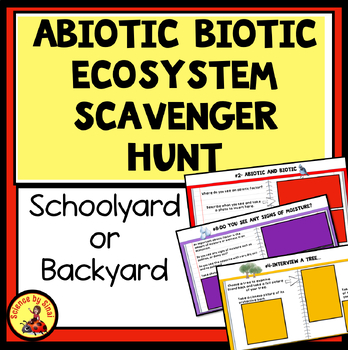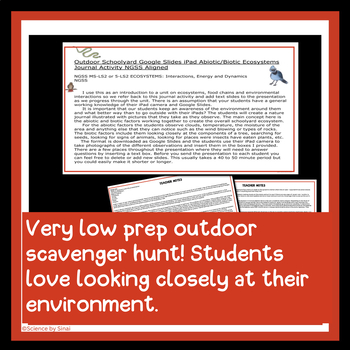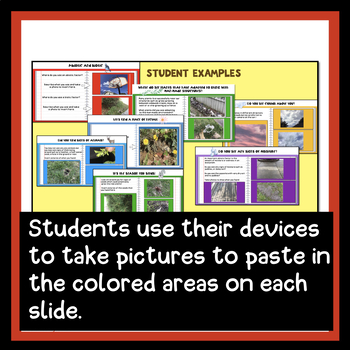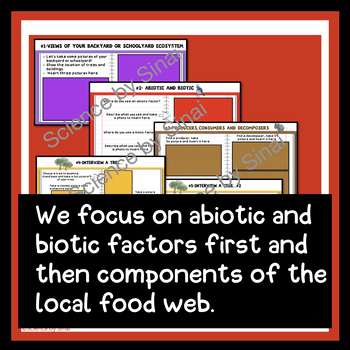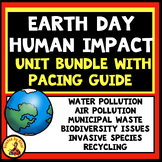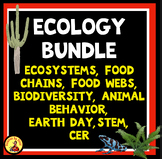ABIOTIC BIOTIC ECOSYSTEMS Outdoor Activity Schoolyard Backyard Digital or Print
- PPTX
What educators are saying
Also included in
- Here is my 2-3 week unit bundle for teaching Human Impact and Earth Day as part of MS-ESS3-3, MS-LS2-3 and MS-LS2-4. Easy prep activities. There is a detailed pacing guide that also includes links to my blog posts that helps you build out each activity. Please see the detailed preview.Topics IncludePrice $51.80Original Price $64.75Save $12.95
- Full Ecology unit for middle school with a variety of 30 low or easy prep resources included. NGSS friendly STEM projects, labs, games, and hand-on activities keep student engagement high. Everything has been tested in my classroom and tweaked over many years. I calculated that it comes out to aboPrice $96.00Original Price $120.00Save $24.00
- After teaching science for over 30 years, I finally put together my middle school and upper elementary ecology and environmental science, ecosystems, food chains and webs, biodiversity, Earth Day, STEM and CER resources! Click on the preview for complete details!The resources range from interactivePrice $252.60Original Price $315.75Save $63.15
Description
Take students outside to observe biotic and abiotic factors(living and nonliving) with this fun environmental scavenger hunt lab activity as part of NGSS MS-LS2-2 or 5-LS2-1.
I use this scavenger hunt as an introduction to a unit on ecosystems, food chains and environmental interactions so we refer back to this journal activity by adding text slides to the presentation as we progress through the unit. To complete this fun activity there is an assumption that your students have a general working knowledge of their camera and Google Slides or Powerpoint.
It is important that our students keep an awareness of the environment around them and what better way than to go outside with their devices? The students will create a nature journal illustrated with pictures that they take as they observe. The main concept here is the abiotic and biotic factors working together to create the overall schoolyard ecosystem.
For the abiotic factors the students observe clouds, temperature, the moisture of the area and elements such as the wind blowing or types of rocks. The biotic factors include them looking closely at the components of a tree, searching for seeds and flowers, looking for signs of animals, looking for places were insects have eaten plants, etc. There is also a slide for observing how plants adapt to our man made structures.
Students use their device camera to take photographs of the different observations and insert them in the boxes provided. There are a few places throughout the presentation where they will need to answer questions by inserting a text box. Before you send the presentation to each student you can feel free to delete or add your own slides. This usually takes a 40 to 50 minute period but you could easily make it shorter or longer.
==>Please visit my blog post on how I use this resource in my classroom. Ecosystem Scavenger Hunt for Backyard or Schoolyard
I would really appreciate a review when you get a chance as this helps me know what is helpful for future products. Thank you so much and advance!
Please check out my digital science notebook templates.
DIGITAL SCIENCE NOTEBOOK TEMPLATE Google Slides with Student Examples/ Rubric
Other environmental activities
Food Chain Drag and Drop Activity
Food Web Biodiversity Dice Roll Game
MS-LS1-4 Behaviors Adaptations for Sucessful Reproduction DIGITAL GOOGLE SLIDES
Living or Nonliving Microphotograph Task Cards
Mammals, Birds, Reptiles and Amphibians of a Temperate Forest
There are several methods I use to get this resource to students.
- Since this is a PowerPoint, I simply upload it into a Google slides presentation and share it on Google Classroom with each individual student. The students can then copy which slides they want and paste them into their own Google Slides unit presentation and add text boxes.
- You can export the PowerPoint into images and then send the images to them in Google Classroom.
- You can download the PowerPoint into images and place all of the images into a Google Drive folder to share with the students.
- If you are using iPads, in the same room as the students, you can simply AirDrop the images, Powerpoint or Google Slides presentation to their iPads .
If you have any questions at all, as to how to use these, please contact me at Karensinai2@gmail.com and I am more than happy to help you!
Are you looking for other science resources? NGSS aligned activities? Science classroom decor or clip art? Please check out the rest of my store at SCIENCE BY SINAI.
https://www.teacherspayteachers.com/Store/Science-By-Sinai
Follow Me
Do you want to be the first to find out when I post a new resource? Please click on the green star next to my name to FOLLOW MY STORE, SCIENCE BY SINAI, and to get an email each time I post a new product. As a follower you will also get notifications of freebies and sales!
Check me out on social media.
https://www.pinterest.com/karensinai2/
https://www.instagram.com/sciencebysinai/
https://www.facebook.com/Science-by-Sinai
Feedback
**Did you know that you can save money on TpT resources by leaving feedback? Go to your “My Purchases“ page and leave feedback on the resources you’ve purchased to earn TpT credits!
Copyright.
Each purchase is a license for ONE person to use in a classroom setting. It is a violation for individuals, schools and districts to redistribute, edit, sell, or post this item on the Internet or to other individuals. Disregarding the copyright is a violation of the Digital Millennium Copyright Act and subject to legal action. By purchasing this product you acknowledge that you have read and understood these terms of use.

